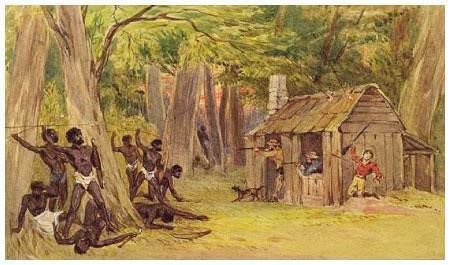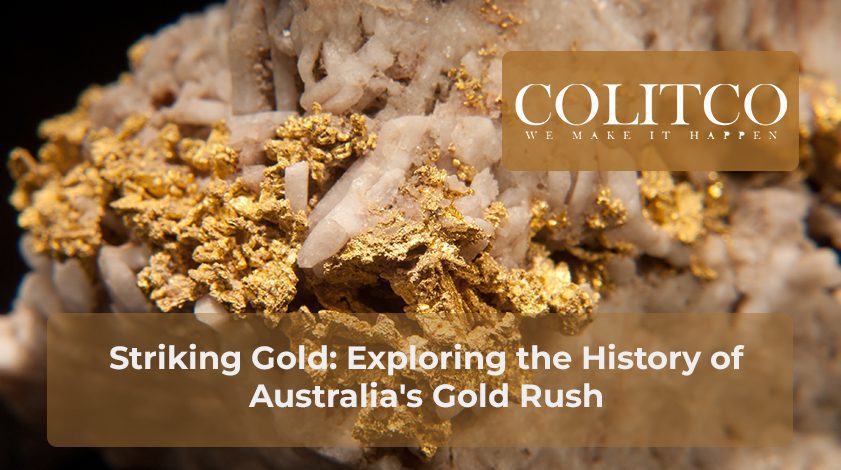
DELVING INTO AUSTRALIA’S GOLD RUSH HISTORY
Welcome to the fascinating world of the Australian Gold Rush! It’s a tale of courage and risk-taking, as people worldwide travelled to Australia to seek their fortune in the gold fields.
In this article, we’ll explore the history of the gold rush in Australia and how it shaped the nation into what it is today. Learn about the different regions, the people, the legacy of the gold rush, and how it ended.
So buckle up and join us on an exciting journey through Australia’s gold rush history!
History of the Gold Rush in Australia
Exploring the history of the Australian gold rush is a captivating journey essential to understanding the nation’s past. It was a time of great adventure and risk-taking. With the discovery of gold came hopes for a new and prosperous life and the promise of a better future.

AUSTRALIAN GOLD RUSHES
Let’s delve into the detailed history of the gold rush in Australia.
The Days of the Gold Rush

PROSPECTORS EXTRACTING GOLD
The first gold rush in Australia occurred in New South Wales in 1851, when Edward Hargraves, an Australian prospector, stumbled across a gold nugget in Ophir, a village near Orange. Hargraves proclaimed that the gold he had found was similar to the gold found in California, prompting other prospectors to come to the region in search of gold.
The news of the gold discovery quickly spread, and prospectors from around the world (mainly the United States and the United Kingdom) flocked to the region in search of gold.
As a result, the population of New South Wales increased exponentially. By 1853, the rush had spread to the Victorian goldfields, where they found gold at Ballarat and Bendigo. Those towns were transformed from small settlements into bustling gold-mining towns within a year.
The influx of prospectors had several economic and social impacts on the region. Gold seekers often clashed with the local Aboriginal population.
Additionally, the gold rush created an economic boom in the region, as businesses quickly sprung up to cater to the needs of the prospectors.
The End of the Gold Rush

The gold rush eventually died out in the early 20th century as the gold deposits became harder to find and more expensive to mine. However, its legacy lives on through the many towns and cities established during this period.
Today, gold is still mined in Australia, although the focus has shifted from the alluvial gold-bearing fields of the 19th century to underground mining operations. Gold is still an essential part of the Australian economy, with the mining industry contributing billions of dollars yearly to the national economy.
The legacy of the gold Rush continues to reverberate in other ways too. For instance, Indigenous Australians still fight for their rightful recognition in the Australian constitution. The Australian government has taken due steps to recognise the rights of Aboriginal Australians, and only time will show us the results of the same.
The Impact of the Gold Rush

MELBOURNE IS TURNING INTO A CITY
The influx of people that the gold rush brought significantly impacted the nation’s economy, population, and culture.
Between 1851 and 1871, the Australian population increased significantly, growing from 430,000 people to 1.7 million. This fourfold growth caused a significant change in the nation’s economy, as miners spent money on food, supplies, and other goods. In addition, the gold rush helped boost the nation’s exports as gold was sent abroad to be sold.
While it brought a lot of wealth and prosperity to the nation, it severely impacted the Aboriginal culture and society.
Tribal violence, diseases brought by outsiders, and the loss of land and resources led to a steep decline in the birth rate of the Aboriginal population. At the time gold was discovered in Victoria, the Aboriginal population had drastically decreased to a total of around 2,000 individuals.
The British government established a “protectorate” system in Port Phillip to control the situation. This system appointed a chief protector and four assistants to encourage Aboriginal people to move to reserves away from towns.
The introduction of sheep and cattle to the land caused further disruption. They scared away game, trampled grasslands and waterholes, and devoured the root vegetables that were a significant part of the Aboriginal people’s diet.
In some cases, Aboriginal people resorted to taking food from the settlers, which led to confrontations and reprisals.

CONFLICT BETWEEN AUSTRALIAN ABORIGINALS AND GOLD PROSPECTORS,
In conclusion, the Australian Gold Rush of the 1850s was a transformative period for the nation, bringing immense wealth and newfound prosperity to many settlers. Despite the serious issues with the aboriginals, the legacy of the gold rush still lives on in the culture and history of Australia, and it remains an integral part of the nation’s heritage.
Frequently Asked Questions (FAQ)
Welcome to the Australian Gold Rush FAQ! Here are answers to some of the most frequently asked questions about one of Australia’s most critical periods.
1. What were the benefits of the Australian Gold Rush?
It brought a large number of immigrants to Australia, introducing multiculturalism and influencing the “White Australia Policy.” The newfound wealth enabled Britain to grant self-government, leading to the implementation of new legislation and policies and the eventual federation of the states in 1901. It also improved transportation.
Most importantly, the gold rush helped develop democracy in Australia.
2. How does Australia’s Gold Rush compare to California’s 1849 Gold Rush?
- The California gold rush and Australia’s gold rush of the 1850s both saw a rush of people arriving to prospect for gold.
- The California gold rush was much larger, with an estimated 90,000–300,000 people arriving to seek their fortune, while Australia’s gold rush was much smaller, with an estimated 10,000–20,000.
- The same technologies were used in both places, such as gold pans, cradles, and flumes.
- Furthermore, the miners’ attire was nearly identical to their imported food and medical supplies.
3. What were the environmental impacts of the Australian gold rush?
- The influx of prospectors led to widespread deforestation and land clearing as they sought new gold fields.
- The construction of dams and other goldfield infrastructure caused further disruption to the natural environment.
- The extensive use of mercury in gold processing caused significant pollution in the surrounding areas.
4. Why did the gold rush end in Australia?
The Australian gold rush ended in the late 19th century because much of the gold was found. As the gold became scarcer and more difficult to find, miners had to search deeper to locate ore deposits. The cost of mining had become too expensive, and the population of miners had decreased.
If you’re interested in learning more about Australia’s recent gold exploration projects, check out our articles on the most promising exploration companies.
Don’t miss out on this opportunity to get an insider’s look into Australia’s gold mining world.
Disclaimer











